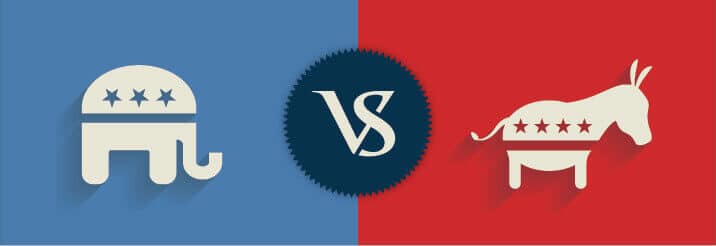Bop Design, a San Diego based web design and marketing firm, has analyzed the websites of the top tier presidential candidates: Obama, Romney and Perry. “A presidential campaign’s website is not only a critical fundraising tool, but also a way for a voter to ‘dig deeper’ and truly understand a candidate’s positions and biography. A candidate’s ‘complete picture’ may not come across in one debate or interview. Through their website, a voter is granted better access to a candidate,” says Jeremy Durant, Bop Design Principal. A candidate’s website design is an invaluable branding tool that helps position a candidate’s brand in the political arena. Bop Design Creative Director, Kara Jensen, elaborates, “Yes, every candidate will utilize the red, white, blue motif to highlight their patriotism, but there are certain design components that will subtlety communicate and resonate with a specific demographic.”
According to the Pew Internet & American Life Project, 73% of adult internet users (representing 54% of all US adults) went online to get news or information about the 2010 midterm elections, or to get involved in the campaign in one way or another (www.pewinternet.org). As more information is being gathered on the internet, a candidate’s website is just as important as traditional media in communicating to likely voters. As of October 2011, the top three presidential candidates in major polls are Obama, Romney and Perry. The Bop Design team analyzes all three candidates’ websites and gives suggestions on how to better position a candidate’s brand and how to improve the effectiveness of a campaign’s website design.
Barack Obama
https://www.barackobama.com/
Introduction
The Barack Obama website is designed like a blog or social media profile – simple yet strong and clean with attractive typography. The website communicates the visual brand with unique color and texture, unlike other candidates who use more traditional reds and blues. This implies a more youthful image. The design conveys a brand position of youthful, idea-oriented, and connected.
Positives
The blog/social media style can be effective with attracting a younger, more web savvy audience. The blog style implies that the website is updated frequently and is in constant flux, as opposed to a more “more polished” website that may not be updated as frequently. The design allows for constant updates and interaction with website visitors. “The design allows for an administrator to update continuously without affecting the design consistency. This can allow for a website to serve as a true resource center for supporters, allowing them to read updates and be informed on current events,” states Jensen. “Supporters feel that they are more connected to the campaign.”
Potential Negatives and Suggestions
The cascading, blog style makes it more difficult for users to access important information without scrolling. A wider layout with a traditional home page and more “call to action” buttons will help a visitor navigate more effectively. The blog style may seem messy and disorganized to an older demographic. “Younger audiences are on social media profiles and blogs more than traditional websites, so the blog style works for them. However, an older audience may be overwhelmed with the amount of text on the homepage,” explains Durant. The website does not provide stances on issues, which may be redundant since he is the current President, but is still helpful for people to compare candidates.
Mitt Romney
https://www.mittromney.com/
Introduction
Clean and simple design with a large rotating banner on homepage – serves as an effective attention getter without being too fast and harsh on the eyes. The website is designed like a conventional Fortune 500 company website, which will be more recognizable to visitors and allow for intuitive browsing. The design conveys a brand position of business-oriented, powerful and traditional.
Positives
The website design allows for a website visitor to find what they are looking for in a timely manner – two clicks or less. Jensen adds, “A website’s hierarchy and content strategy must be purposeful, so that a visitor can find information in a minimal number of clicks. If this does not happen, a visitor will lose patience and leave a website.” The website presents a polished image similar to Romney’s brand position in the campaign. The website design allows for display of both static information (candidate positions, biography, etc.) combined with changing information (news, events, etc.).
Potential Negatives and Suggestions
The homepage icon button designs can be visually overwhelming and the clutter may overwhelm some visitors. Also, the donate button is highlighted at the top navigation but there is no donate button at the bottom navigation. “It’s advisable to include a donate page at the bottom of each page so there is a clear call to action after completing a section,” advises Durant.
Rick Perry
https://www.rickperry.org
Introduction
Clean and simple design with a fresh logo that stands out for its 3D qualities. The layout is simplistic with effective typography. The lack of clutter makes it easy to read and navigate. The design conveys a brand position of plainspoken, direct and effective.
Positives
A straightforward, basic design. The website consists of a strong, attention-grabbing header with intuitive navigation. Includes pages with news, candidate stances, social media buttons and newsletter sign-up for connecting with people. “The Perry campaign has a website design that emulates their candidate’s brand position – a leader with ‘no nonsense’ solutions to complex problems,” explains Jensen.
Potential Negatives and Suggestions
The website design is so simple it borders on boring. The site is not as robust as other candidate websites – this may convey the idea that the candidate has not developed specific plans for certain issues. The lack of robust information and simplistic design may not excite website visitors enough, prompting them to continuously visit. “The website design is monotone compared to Perry’s political rivals. For example, there is too much blue on the homepage. The overuse of the blues in the background and header make it visually monotone and stand out less,” says Durant.
Conclusion
Each presidential candidate’s website consists of strong and weak website components. “A presidential candidate’s website is more difficult to design than a small business website for example, that usually targets a niche client,” explains Durant. A candidate is targeting the American voter, each with varying interests, lifestyle, background, etc. This is the challenge to a web designer, conveying critical information about a candidate in a concise manner and ensuring the brand position resonates with potential voters and donors of various political persuasions.



